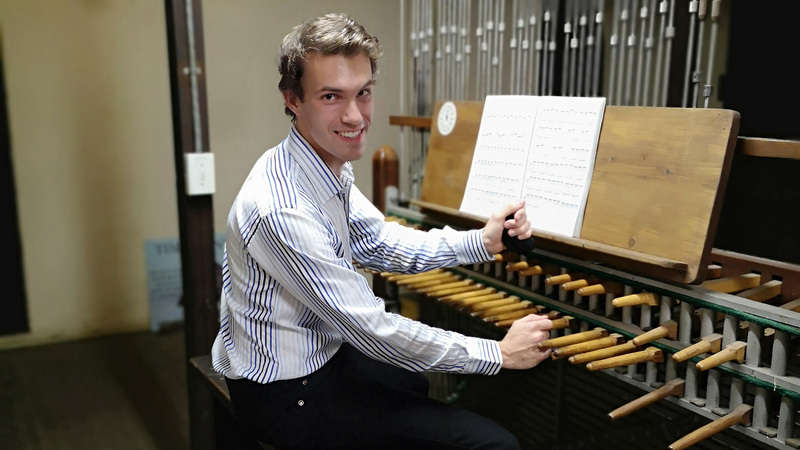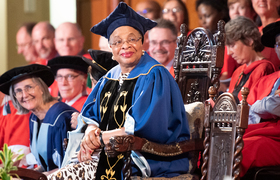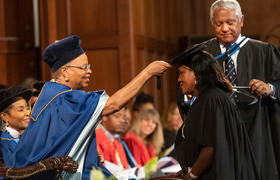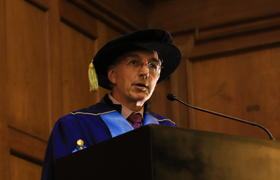Bells (and whistles) for grad organist
24 March 2020 | Story Helen Swingler. Photos Supplied. Read time 8 min.At age nine Alexios Vicatos repaired his first clock. By his early teens he was restoring antique timepieces for local antiquarians. His love of things mechanical recently saw him rehabilitate and perform on the City Hall’s carillon, an instrument last played almost two decades ago. Meet the multifaceted University of Cape Town (UCT) PhD candidate in chemistry whose music welcomes scores of students and guests to graduation.
Alexios has undergraduate majors in chemistry and environmental and geographical science from UCT. He also studied the organ at first-instrument level at UCT’s South African College of Music (SACM) as part of his degree. He started playing the organ at graduations in 2014, entertaining guests before the ceremony and accompanying the national anthem.
The 15-ceremony March 2020 graduation season would have seen Alexios at the keys and pedals once again (though not the only grad organist). Sadly, this has been postponed due to the COVID-19 outbreak.
The emotional energy of these celebrations brings a vicarious joy, he said, especially for those celebrating their first family graduation.
Honoured at grad
Alexios has played at his own graduation ceremonies, hood draped across the organ bench. His first ceremony was for his bachelor’s degree in 2014, where he received a distinction in chemistry; his second was for his chemistry honours degree, awarded with distinction in 2015; and his third was for his master’s degree, awarded with distinction in December 2018 at a graduation that included Vice-Chancellor (VC) Professor Maokgethi Phakeng’s robing ceremony.
At this ceremony he was one of seven graduands the VC chose to honour by sharing their accomplishments with the assembly, such as Alexios’s musical contributions to UCT, his science degrees, his positive teaching reviews, as well as his restoration of the historic grandfather clock at the SACM.
It was a photo-frame moment.
“Chancellor Graça Machel capped us,” he recalled. “And when she congratulated me, she also encouraged me to continue with all my many pursuits. My whole family was there – it was extremely special.”
Where it all began
All these pursuits have flourished over the years from that first childhood encounter with clock mechanisms, which led to a growing love of horology (the art of clock- and watchmaking). As Alexios said, horology “suits my personality, as I like to produce meticulous and accurate work”.
He has moved on to much larger timepieces, such as the SACM clock, which strikes boldly every hour after many years of being silent.
His passion for restoring clocks all began with his mother’s small, broken cuckoo clock.
“I begged her to get it repaired,” he said. But the repair work was disastrous and Alexios, then aged eight, realised that he’d have to learn how to repair clocks.
“When I discovered all the moving parts, I thought that this is fantastic! A 3D working puzzle!”
“I had no idea that there were moving gears inside. When I discovered all the moving parts, I thought that this is fantastic! A 3D working puzzle!”
At the age of nine he began restoring small alarm timepieces but wanted to learn more. When he was 11, he was fortunate to be mentored by a watchmaker.
“One day he gave me a clock and said, ‘Okay, take this, repair it and then show me,’ and he would give me books so that I could understand the geometry in clocks.”
Various antique dealers that he got to know in Cape Town also encouraged the young boy and gave him books on clock restoration.
“That’s how I learnt to restore antique clocks.”
In the clocktower
By happy chance, it was his love of clocks that recently introduced Alexios to a particularly special piece that married his love of things musical and mechanical.
He visited the Cape Town City Hall’s clocktower to see its historic clock. That was interesting, but even more so was the unusual, long-forgotten instrument he’d heard had a home in the rafters.
It was a carillon – a colossal instrument that rings tower bells, played manually on a keyboard, with both hand batons and foot pedals, which are connected through a network of levers to clappers striking a set of chromatic bells. The bells are hung on a grid framework and don’t move.
“I’d never seen anything like it.”
“I’d never seen anything like it.”
The City Hall carillon has 39 tower bells, ranging from 20 cm to 1.5 m in diameter. The foundry that originally cast these bells, the John Taylor & Co bell foundry in Loughborough, still operates; good news as Alexios is keen to fundraise for the remaining 11 bells it requires.
Known in Dutch as the beiaard, this musical instrument dates back to the 16th century. The Cape Town City Hall carillon has a fascinating history: it is the only carillon in Africa, and it was the first carillon worldwide to be conceived as a war memorial, dedicated to fallen South African soldiers after Armistice Day on 11 November 1918.
This was the idea of the mayoress, Anna Thorne, who established a committee of 40 women to organise and contribute towards the fundraising of the carillon as a war memorial, hence its official name, the Women’s War Memorial. The carillon was inaugurated in 1925 and it was the largest local initiative for a war memorial of its time.
PhD candidate and grad organist Alexios Vicatos at work restoring the Cape Town City Hall carillon, otherwise known as the Women’s War Memorial, a tribute to fallen South African soldiers in the First World War.
The official revival of the instrument took place on the centenary of Armistice Day on 11 November 2018 at 11:00 when Alexios performed on the carillon and spoke about it to a large interested group of people in the bell tower.
“I thought I could maybe learn to play something on it.”
Though Alexios has no formal training in playing the carillon, he read various texts on the technique and analysed the way in which professionals play. He ordered the 11 preludes for carillon composed by the 17th-century musician, Matthias van den Gheyn. Soon after he started practising, he realised that the carillon wasn’t in good shape. It wasn’t long before Alexios was at work restoring it, with the help of Garth Hammer (Steinway-trained piano technician) and his father, UCT’s Associate Professor George Vicatos of the Department of Mechanical Engineering.
Call to collaborate
Alexios has started playing the instrument for various events and before symphony concerts.
And news spreads.
He soon heard from Tiffany Ng, an assistant professor of carillon and university carillonneur at the University of Michigan in Ann Arbor in the United States. She was keen on a collaboration. The plan is to premiere a black composer’s work for the carillon, coordinating the performances at the same time in South Africa and at the University of Michigan. The event aims to turn the first carillon work by a black composer into a significant international event.
“She wanted to collaborate with South Africa because of our country’s past and our efforts to forge integration.”
“She wanted to collaborate with South Africa because of our country’s past and our efforts to forge integration in different ways,” said Alexios.
As for his academic career, Alexios may well have another special graduation organ performance lined up when he receives his PhD in supramolecular chemistry, hopefully at the end of 2021.
 This work is licensed under a Creative Commons Attribution-NoDerivatives 4.0 International License.
This work is licensed under a Creative Commons Attribution-NoDerivatives 4.0 International License.
Please view the republishing articles page for more information.
















